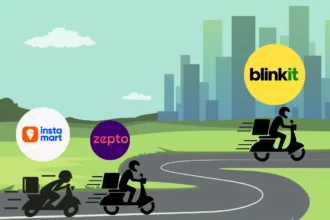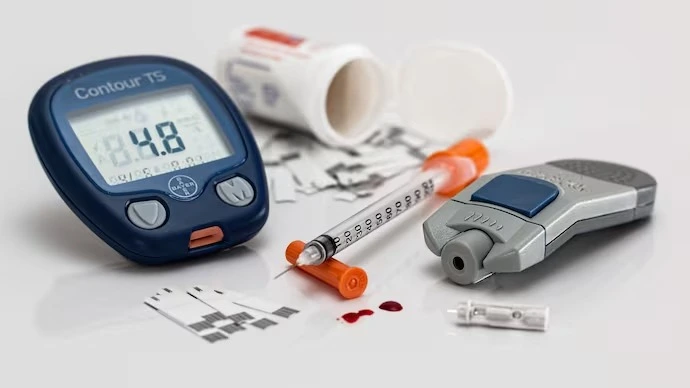Estimated Reading Time: 20-24 minutes (3,900 words)
Introduction
Diabetes has become one of India’s most urgent health challenges — and it’s growing faster than most people realize. With nearly 90 million adults living with diabetes and millions more undiagnosed, India now faces a metabolic epidemic that touches almost every family, every workplace, and every age group. Rapid urbanization, sedentary routines, processed foods, rising stress, and limited early screening have all accelerated the crisis. But alongside this worrying trend, something new is happening: a wave of health technology innovation is transforming how Indians track, prevent, and manage diabetes.
From continuous glucose monitors (CGMs) that show real-time glucose trends, to AI-powered risk prediction, to digital therapeutics, smart wearables, and telemedicine, the country is entering a new era of data-driven, personalized diabetes care. These technologies are breaking old barriers — making monitoring easier, improving adherence, reducing complications, and empowering people to take control of their health without constant clinic visits. For the first time, advanced tools once limited to specialists are becoming accessible to everyday users, and adoption is rising across metros, Tier-2 cities, and even rural districts.
This blog breaks down India’s current diabetes landscape and explores the top technologies reshaping prevention and treatment in 2025. Whether you’re a patient, caregiver, doctor, content creator, or simply health-conscious, this guide will help you understand what’s changing, what’s working, and where the biggest opportunities lie in this rapidly evolving space. Let’s dive into the innovations that could redefine India’s fight against diabetes in the coming decade.
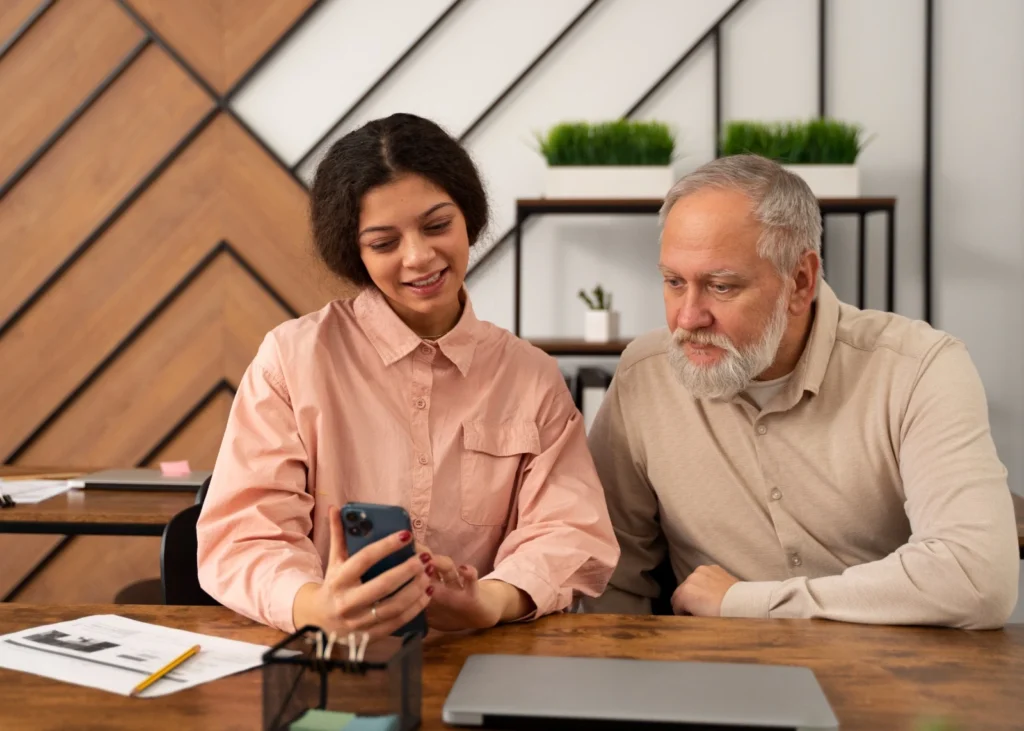
Why This Matters: The Current Scale of the Diabetes Crisis (Global + India)
🌍 Global Picture: A Rapidly Escalating Health Emergency
Diabetes is no longer a “chronic lifestyle disease”; it is now a global megatrend in healthcare, growing faster than most countries’ preparedness levels.
- Latest global estimates (2024, Lancet + NCD-RisC):
More than 800 million adults worldwide are living with diabetes — significantly higher than earlier projections of 500–600 million. - This represents a doubling since 1990, with the steepest rise seen in low- and middle-income countries.
- Future outlook:
- By 2050, global cases could surpass 1.3 billion, largely driven by:
- urbanization
- sedentary lifestyles
- unhealthy diets
- ageing populations
- genetic predispositions in certain ethnic groups (including South Asians)
- urbanization
- By 2050, global cases could surpass 1.3 billion, largely driven by:
💥 Economic Toll of Global Diabetes
- Global health expenditure on diabetes crossed $966 billion in 2023 (IDF).
- Nearly 1 in every 4 healthcare dollars in some countries goes toward diabetes-related care.
- Productivity loss, absenteeism, and complications (kidney disease, heart disease, amputations) expand the burden far beyond treatment costs.
🇮🇳 India’s Diabetes Burden: One of the World’s Largest
India sits at the epicenter of the global diabetes crisis.
📊 Hard Numbers (2024–2025)
- 89.8 million adults in India are living with diabetes (IDF Diabetes Atlas 2024).
- That’s roughly 1 in every 10 adults.
- India, China, and the U.S. together account for ~40% of global cases.
🚨 Regional Insights
Recent ICMR-INDIAB findings reveal staggering patterns:
- Several states show prevalence above 12–15% (Kerala, Punjab, Tamil Nadu).
- Urban prevalence is often 2–3× higher than rural.
- Younger adults (25–44 age group) are increasingly affected — a worrying trend for India’s demographic dividend.
🍽️ Why Indians Are More Vulnerable
South Asians carry unique risk factors:
- lower BMI but higher visceral fat
- genetic insulin resistance
- high-carbohydrate diets
- rapid dietary transition (processed foods, sugary beverages)
This means Indians develop diabetes earlier, at lower body weights, and experience more complications.
🩺 Silent Crisis: Undiagnosed & Untreated Diabetes
One of the most alarming elements is the hidden population:
- Globally:
Around 240 million people have undiagnosed diabetes (WHO). - India:
Studies show over 50% of diabetics may be unaware of their condition — especially in rural and low-income communities.
This leads to late diagnosis, often only when complications appear:
- chronic kidney disease
- cardiovascular complications
- vision loss
- limb amputations
- neuropathy
Delayed diagnosis massively increases healthcare costs and reduces quality of life.
💰 The Financial & Social Impact in India
- India spends over ₹1.5–2 lakh crore annually on diabetes-related health problems.
- Diabetes is a major reason for:
- hospitalizations
- long-term medication use
- productivity loss
- hospitalizations
- Families often face catastrophic out-of-pocket expenses, especially for complications like dialysis.
⚠️ The Implication: Why Tech Solutions Are No Longer Optional
The sheer scale of the crisis makes traditional, clinic-based care unsustainable.
India urgently needs scalable solutions that include:
1. Affordable, continuous glucose monitoring at home
To reduce dependence on frequent lab visits and late diagnosis.
2. Remote care & AI-based treatment personalization
To bridge doctor shortages — India has 1 endocrinologist per ~400,000 patients.
3. Preventive digital programs
App-based lifestyle coaching, diet tracking, fitness monitoring.
4. Smart medication adherence tools
Reminders, digital pill boxes, AI pattern tracking.
5. Wearables and sensors for real-time data
FBG/PPG tracking, insulin delivery optimization, risk prediction models.
6. Population-scale health dashboards
Government & hospital systems using big data to predict hotspots and improve resource distribution.
🔍 Bottom Line
India’s diabetes wave is too large, too fast, and too complex for traditional healthcare to handle alone.
Tech-enabled solutions are no longer just helpful — they are mission-critical.
They help identify patients earlier, personalize treatment, enhance compliance, reduce complications, and lower long-term costs.
Top Technologies Helping India Fight Diabetes
India’s diabetes challenge requires technology-driven, scalable, and cost-efficient solutions. Below are the major innovations, how they work, what scientific evidence backs them, the current India-market landscape, and how you can create high-traffic blog content + affiliate hooks around each.
A. Continuous Glucose Monitoring (CGM)
What It Is
A tiny wearable sensor placed on the arm or abdomen that measures interstitial glucose every 1–5 minutes. Data is sent to a smartphone or reader. Leading brands:
- Freestyle Libre (Abbott)
- Dexcom G7
- Medtronic Guardian Connect
- Ultrahuman M1 (India-first metabolic CGM ecosystem)
Why It Matters
CGM has completely transformed diabetes care:
- Tracks glucose 24×7, including nights and exercise periods
- Shows trends (rising, falling, stable)
- Measures Time in Range (TIR) — now considered as important as HbA1c
- Sends alerts before highs/lows
- Reduces painful finger-pricks
- Helps tailor insulin, diet, sleep, activity & medication patterns
Clinical Evidence:
- RCTs show CGM reduces HbA1c by 0.5–1.0% for insulin users
- 40–60% reduction in severe hypoglycemia
- CGM adoption is now recommended by ADA 2025 Guidelines even for Type 2 patients on basal insulin
- Indian real-world data (AIIMS/Endocrine Society) shows CGM helps detect unrecognized nocturnal hypoglycemia—a major problem in Indian insulin users
India Market Snapshot (2024–2033)
- Indian CGM market size (2024): ~USD 138.9 Million
- Expected to reach USD 672.9 Million by 2033
- CAGR: ~19.1% (Grand View Research)
- Reports for 2025 estimate USD 200–220 Million, reflecting rapid adoption and price reductions
- Growth drivers:
- Ultrahuman-led metabolic tracking trend
- Falling sensor costs
- Rising T2 diabetes + prediabetes (~136 million Indians combined)
- Insurers exploring coverage for CGM-based chronic programs
- Ultrahuman-led metabolic tracking trend
India-Specific Challenges
- High out-of-pocket costs
- Limited insurance reimbursement
- Low CGM awareness outside metros
B. Insulin Delivery & Automated Insulin Delivery (AID) Systems
What They Are
- Insulin pens (most common in India)
- Insulin pumps (patch, tubed, disposable)
- Closed-loop AID systems
- CGM + Pump + Algorithm
- Automatically adjusts insulin delivery every few minutes
- CGM + Pump + Algorithm
Leading global brands: Medtronic 780G, Omnipod 5, Tandem t:slim Control-IQ
India players: Medtronic, Roche Accu-Chek Insight pumps, Omnipod (import)
Why It Matters
AID systems deliver better glucose control with less mental burden:
- Increases Time in Range by 10–20%
- Reduces hypoglycemia by 30–60%
- Automates correction boluses
- Helps T1D patients manage unpredictable glucose swings
- Strong evidence from NEJM, ADA & Endocrine Society
India Market Snapshot
- Pump adoption is still below 5% among insulin users
- Higher uptake in metros like Bengaluru, Chennai, Mumbai
- Key barriers:
- Cost (₹2–6 lakh/year including consumables)
- Limited trained educators
- Import dependency
- Cost (₹2–6 lakh/year including consumables)
- However growth is accelerating via:
- Hospital-led structured insulin pump programs
- Financing/EMI models
- Parents of T1D children increasingly adopting pumps
- Hospital-led structured insulin pump programs
C. Digital Therapeutics (DTx) & Diabetes Apps
What They Are
Clinically validated software programs + app-based coaching that offer:
- Personalized diet plans
- Activity & habit nudges
- Medication reminders
- CGM integration
- Doctor consults
- Predictive risk scoring
Examples: BeatO, Ultrahuman, Wellthy Therapeutics, HealthifyMe, Fitbit app integrations
Why They Matter
DTx works because it attacks lifestyle—the core driver of Type 2 diabetes:
- RCTs show 1.2–2% HbA1c reduction
- Sustained 2–6 kg weight loss
- Improved medication adherence
- Culturally adaptable (Indian diets, languages, festivals)
They are also highly scalable, making them a perfect solution for India’s crowded health system.
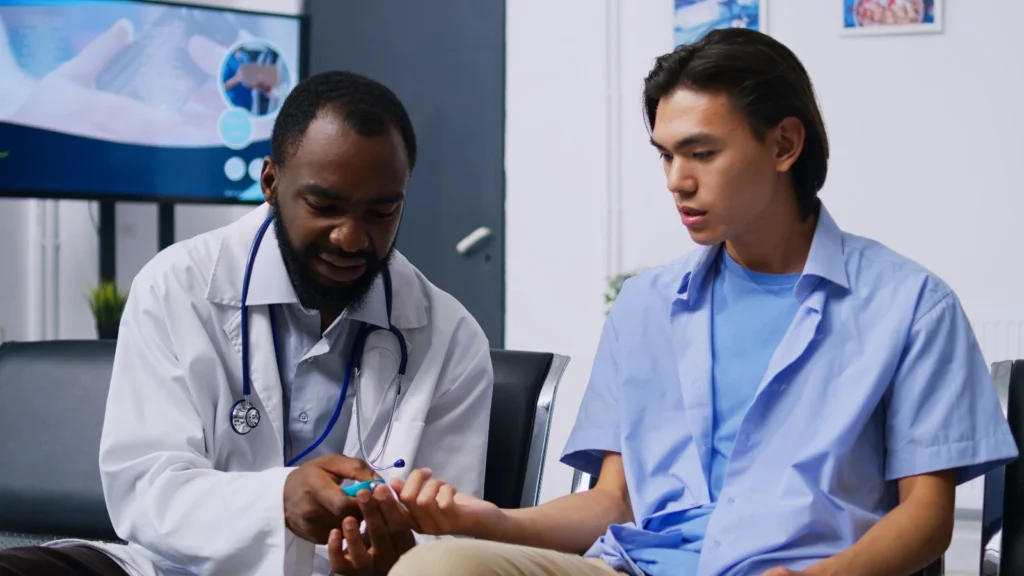
India Market Snapshot
- India DTx market: >$500M by 2030 (estimates from Deloitte/McKinsey)
- Adoption rising through:
- Employer wellness programs
- Insurer tie-ups (cashless digital disease management)
- Bundling with CGM subscriptions
- Employer wellness programs
D. Telemedicine & Remote Monitoring
What It Is
- Video consults with endocrinologists
- Sharing CGM/FSL data during online visits
- Remote insulin titration
- Nurse-led follow-ups
- WhatsApp-based programs for rural communities
Why It Matters
- India has only 1 endocrinologist per 400,000 diabetes patients
- Telemedicine bridges the gap for Tier-2/3 cities
- Major hospitals (Apollo, Fortis, Aster) now run tele-diabetes clinics
- Improves continuity of care: fewer emergencies, smoother dose adjustments
Post-COVID Acceleration
- NATIONAL TELEMEDICINE SERVICE (eSanjeevani) crossed 200 million teleconsults
- HbA1c improvement has been documented when remote monitoring + CGM are used together
E. AI & Predictive Analytics in Diabetes Care
What It Is
AI models can:
- Predict diabetes risk years in advance
- Forecast post-meal glucose responses
- Personalize insulin dosing
- Detect retinal disease via smartphone photos
- Identify early kidney decline (eGFR/creatinine models)
Notable players:
- Google Health (retinopathy AI)
- Ultrahuman (glucose prediction models)
- BeatO AI risk engine
- WHO-approved AI-based retinal screening
Why It Matters
AI can dramatically increase early detection:
- Detect retinopathy with 90%+ accuracy
- Predict future HbA1c changes
- Identify “hidden prediabetes” populations
- Help rural health workers with early triage
Clinical & Regulatory Considerations
- AI models need validation
- Caution with insulin dose prediction algorithms
- India exploring AI medical device guidelines (CDSCO)
F. Wearables & Lifestyle Sensors
What They Are
Devices that track health parameters and integrate with diabetes apps:
- Smartwatches (Apple Watch, Samsung, Pixel)
- Fitness bands (Fitbit, Amazfit, Noise)
- Sleep sensors (Oura, Ultrahuman Ring)
- HRV/stress monitors
Why They Matter
Wearables help create a 360° metabolic picture:
- Activity data + CGM patterns
- Sleep quality vs glucose stability
- HRV vs insulin resistance
- Stress-related glucose spikes
- Step count vs post-meal glucose curve
This makes behavior change easier and more personalized.
India Insights
- India is now the biggest smartwatch market in the world by shipments (Counterpoint Research 2023–24)
- Low-cost bands (<₹2,000) have mass adoption
- Integration with CGM apps is a growing trend
Prevention — A Practical 12-Week Action Plan (CGM Optional)
Goal: Reduce diabetes risk, lower HbA1c for prediabetes or early Type 2, improve metabolic flexibility, and build habits that actually last in Indian lifestyles.
Weeks 1–2: Baseline, Awareness & Tracking
- Get your medical baseline: fasting glucose, HbA1c, lipid profile, liver function, kidney function, BMI, waist circumference, and blood pressure.
Most tests are available at ₹699–₹1299 preventive packages across major labs. - Track your routine for 7–10 days:
- Sleep duration
- Meal timings
- Steps per day
- Evening snacking
This creates awareness of patterns that worsen glucose control (late dinners, long sedentary spells, high-carb lunches, etc.).
- Sleep duration
- If using CGM:
- Start a 14-day session, keep a simple food/activity log, and identify glucose spikes from common Indian foods—poha, dosa, bananas, chai + biscuits, fried snacks.
- Note response to stress and poor sleep.
- Start a 14-day session, keep a simple food/activity log, and identify glucose spikes from common Indian foods—poha, dosa, bananas, chai + biscuits, fried snacks.
Weeks 3–6: Diet Reset + Foundational Fitness
This is the core habit-building phase.
Diet upgrades (Indian-context)
- Shift to portion-controlled plates: ½ vegetables, ¼ protein, ¼ complex carbs.
- Swap high GI staples:
- White rice → millets/brown rice
- Maida/Parathas → whole wheat/multigrain rotis
- Sugary breakfast cereals → oats + nuts
- White rice → millets/brown rice
- Add high-fiber foods: rajma, chole, sprouts, bhindi, lauki, spinach, methi.
- Reduce sugar by “laddering down”: 2 spoons → 1.5 → 1 → 0.5 over 4 weeks.
- Hydration goal: 2–2.5L/day, limit fruit juices (common glucose spike triggers).
Movement & exercise
- Daily: 30 minutes brisk walk after meals (post-dinner walk is most effective).
- Resistance training (2 days/week):
- Squats, wall push-ups, lunges, resistance bands.
- This improves insulin sensitivity faster than cardio alone.
- Squats, wall push-ups, lunges, resistance bands.
- Try the “10-3-30 rule”: 10-minute walk within 30 minutes of each meal.
Weeks 7–10: Optimize, Personalize & Re-check
At this stage, your routine stabilizes; now we fine-tune it.
- Re-check weight, fasting glucose, and waist circumference.
- Adjust carb timing:
- Move heavier carbs to breakfast or lunch, lighter meals for dinner.
- Move heavier carbs to breakfast or lunch, lighter meals for dinner.
- Increase protein at each meal: paneer, eggs, dal, chana, sprouts, tofu.
- Improve meal spacing: maintain a 12-hour eating window (e.g., 8 am–8 pm).
If using CGM:
- Review Time-in-Range (TIR) with a clinician or app.
- Identify food patterns that repeatedly push glucose above 160 mg/dL.
- Small tweaks—adding protein before carbs, walking 10 mins after meals, switching chai biscuits → nuts—can improve TIR by 10–20%.
Weeks 11–12: Consolidate, Routinely Monitor & Future Plan
- Draft a 12-week maintenance plan:
- 1–2 indulgence meals per week
- 150+ minutes walking
- 2 resistance sessions
- 7 hours sleep target
- 1–2 indulgence meals per week
- Set automated reminders using apps for:
- Water intake
- Meal logging
- Step goals
- Bedtime
- Water intake
- Schedule your next HbA1c test for 3 months after starting.
- If consistency is difficult, consider:
- Digital therapeutics (DTx) programs
- Health coaches
- Structured app-based challenges
- Digital therapeutics (DTx) programs
Tip:
Behavior change is incremental. Use wearables (smartwatches, CGMs) for data feedback, and apps for accountability—not perfection.
Cost, Accessibility & Equity — The Real Limitations in India
Digital diabetes care is growing in India, but affordability and access remain massive challenges. A balanced blog must highlight these gaps.
1. High Device Costs
- CGM sensors (Freestyle Libre, Dexcom, Abbott), smart insulin pens, pumps, and premium DTx subscriptions cost significantly more than traditional glucometers.
- Prices vary widely (₹1,500 to ₹4,500 per CGM sensor; pumps ₹50,000+ annually).
- Insurance coverage remains limited, except in some employer-backed plans.
- Government subsidy programs are slowly evolving, but uptake is patchy.
2. Insulin Availability & Supply Disruptions
- Several states report irregular insulin supply in government hospitals, pushing vulnerable groups—especially Type 1 patients—toward high out-of-pocket costs.
- Rural and semi-urban patients often pay more due to supply-chain inefficiencies.
- Any tech or device guide must recommend low-cost, high-availability alternatives to remain practical for families with chronic expenses.
3. Digital Divide: Rural vs Urban India
- Telemedicine can greatly improve diabetes care, but access barriers remain:
- Limited internet connectivity
- Low smartphone penetration among older adults
- Language barriers on English-only health apps
- Lack of digital literacy to interpret CGM graphs or reports
- Limited internet connectivity
- To maintain inclusivity, health guides must highlight:
- Low-tech screening options like glucometers
- Free or low-cost follow-ups at NPCDCS clinics
- ASHA workers’ role in early diabetes screening
- SMS-based reminders for patients without smartphones
- Low-tech screening options like glucometers
4. Cultural, Dietary & Awareness Gaps
- Many Indians still perceive diabetes as “mild” or “age-related,” delaying diagnosis.
- High-carb cultural diets, late dinners, and stress-driven snacking widen the education gap.
- Tech alone cannot solve this—community-level awareness and public health education are equally important.
FAQs Section
1. Is diabetes increasing in India?
Yes — significantly.
India is experiencing one of the fastest rises in diabetes cases globally. According to the International Diabetes Federation’s Diabetes Atlas, India had ~89.8 million adults with diabetes in 2024, representing about 10.5% prevalence among adults. This number is projected to cross 100 million well before 2030 if current trends continue.
Key drivers behind the surge include:
- Increased consumption of refined carbs and processed foods
- Urban sedentary lifestyles
- Rising obesity and central abdominal fat
- Genetic predisposition among South Asians
- Declining physical activity in both rural and urban areas
- Higher stress and sleep disturbances
Public health experts describe diabetes in India as a “silent tsunami” because most people remain undiagnosed until complications appear.
2. What is a CGM and who should use it?
A Continuous Glucose Monitor (CGM) is a small wearable device that tracks glucose levels 24×7 using a tiny sensor inserted under the skin. It sends real-time glucose readings to a smartphone or reader every few minutes.
Who benefits most from CGM?
- Type 1 diabetics: CGM is considered essential for safe insulin management.
- Insulin-dependent Type 2 patients: Helps adjust basal/bolus doses more accurately.
- Early Type 2 or prediabetes: Offers insights on food-induced spikes and lifestyle impact.
- Fitness-focused individuals: Increasingly used to biohack glucose and optimize diet/exercise.
- People with hypoglycemia unawareness: Alerts can prevent dangerous lows.
CGM is not just for diagnosis — it is a behavior change tool, helping users see exactly how foods (poha, dosa, sweets), stress, sleep, and late dinners affect glucose.
3. How much does CGM cost in India (2025)?
India’s CGM market is expanding quickly, valued around USD 139 million in 2024, with strong growth expected through 2030.
Costs vary by brand and usage:
- Sensors: Each lasts 10–14 days or 14–30 days depending on model.
- Price per sensor: From moderate to premium (varies significantly).
- Starter kits: Include applicator, sensor, and sometimes a reader.
- Subscription packages: Some companies offer monthly bundles including app access, analytics, and coaching.
Your product review section should include a detailed brand-by-brand comparison covering:
- Price per sensor
- Sensor lifespan
- Accuracy
- App features
- Annual cost
- Local availability
- Insurance or corporate wellness coverage
This helps readers choose based on budget and needs.
4. Can apps and digital therapeutics (DTx) replace doctors?
No.
Apps and DTx platforms are powerful adjuncts, but they cannot replace medical professionals.
What they can do:
- Track glucose, meals, steps, sleep, medication adherence
- Provide reminders, nudges, and behavior-change coaching
- Offer evidence-based diet/exercise guidance
- Support teleconsultations
- Help interpret CGM patterns
What they cannot do safely:
- Diagnose complications
- Adjust insulin dosage independently
- Replace lab tests
- Manage emergencies (hypoglycemia, DKA, infections)
They serve best as continuous support tools, while doctors provide the clinical oversight.
5. Does AI really predict diabetes?
Yes — but with limitations.
AI models can:
- Predict future diabetes risk using historical health data
- Detect early retinopathy/neuropathy through imaging
- Flag patterns in CGM or lab data
- Assist doctors in treatment pathways
However:
- Clinical validation is ongoing
- Regulatory approval frameworks are still evolving
- AI tools can produce false positives/negatives
- AI should support, not replace, clinical judgment
For now, AI is a decision-support tool, not a diagnostic authority.
6. Are insulin pumps available in India?
Yes.
Insulin pumps and hybrid closed-loop/AID (Automated Insulin Delivery) systems are available, mostly in urban diabetes specialty centers.
Availability notes:
- Pumps are less common than insulin pens due to high cost.
- They require training and regular follow-up.
- Popular among Type 1 diabetics and select Type 2 insulin users.
- Annual costs (consumables + pump maintenance) can be substantial.
Adoption is rising as awareness and affordability improve, but pumps still represent a premium segment.
7. What is “Time in Range” (TIR) and why does it matter?
Time in Range (TIR) refers to the percentage of time your glucose stays within the ideal target zone, usually 70–180 mg/dL.
Why it matters:
- Higher TIR = better long-term outcomes
- Lower risk of complications (nerve, kidney, eye, cardiovascular)
- More informative than HbA1c alone because it reflects daily patterns
- Especially valuable for Type 1 and Type 2 patients on insulin
- Helps fine-tune diet, exercise, sleep, and stress habits
TIR is one of the biggest advantages of CGM because it provides real-time data, unlike HbA1c which is an average over 3 months.
8. Can lifestyle changes really prevent diabetes?
Absolutely — and the evidence is strong.
Lifestyle changes can reduce the risk of progressing from prediabetes to full diabetes by 30–58%, according to major global studies.
Effective lifestyle interventions include:
- Losing 5–7% body weight
- Regular exercise (150+ minutes/week)
- Strength training
- Cutting refined carbs
- Improving sleep and reducing stress
Digital therapeutics (DTx) programs in India show measurable improvements in:
- HbA1c
- Weight
- Triglycerides
- Glucose variability
Prevention works — but requires consistency.
9. Does the Indian government support diabetes screening?
Yes.
India’s government runs several large-scale initiatives under the NPCDCS (National Programme for Prevention and Control of Cancer, Diabetes, Cardiovascular Diseases and Stroke).
Support includes:
- Free or subsidized screening at PHCs/CHCs
- Community-based screening via ASHA and ANM workers
- Regular NCD camps in rural area
- Prevention education campaigns
- Risk profiling for adults 30+
- Inclusion of diabetes in Ayushman Bharat’s care pathways
State-level programs (Kerala, Tamil Nadu, Karnataka, Maharashtra, etc.) also offer additional screening and preventive care services.
10. Which wearable is best for diabetes prevention?
There is no single “best” wearable, because the ideal device depends on the user’s needs and budget.
Look for wearables that:
- Track steps accurately
- Monitor heart rate continuously
- Measure sleep stages reliably
- Offer stress/HRV tracking
- Sync with health apps used in India (HealthifyMe, Fitbit, Samsung Health, Google Fit, Apple Health)
- Provide contextual insights rather than just raw numbers
Recommendations should be updated annually because models and prices change frequently.
11. How do I choose between CGM brands?
Compare CGMs across the following parameters:
- Sensor lifespan (10 days vs 14 days vs 30 days)
- Accuracy (MARD score)
- App ecosystem
- Alarms & alerts (predictive vs reactive)
- Wearability & comfort
- Reader vs smartphone-only options
- Price per sensor
- Annual cost
- Insurance coverage
- Local customer support
- Integration with fitness apps / DTx platforms
- Ease of application and removal
User reviews + clinician recommendations help finalize your choice.
12. What are low-cost alternatives for rural areas?
For rural and low-income populations, affordable and practical diabetes solutions include:
- Fingerstick glucometers (cheapest and widely available)
- Community health worker screening using glucometers and risk questionnaires
- NPCDCS and NHM screening camps at PHCs and CHCs
- Basic SMS or IVR reminders instead of smartphone apps
- Low-cost telemedicine consults
- Diet and lifestyle counselling via ASHA workers
- Government-supplied essential medicines (metformin, sulfonylureas, insulin)
Tech should be adapted, not imposed. Low-tech solutions still save lives.
Summary / Key takeaways
- Diabetes is rising globally and in India — India has ~90 million adults with diabetes (2024). Diabetes Atlas
- Technology — CGM, DTx, telemedicine, AI and insulin-delivery innovations — are key levers to improve monitoring, prevention, and outcomes. Grand View Research+1
- Cost, supply, and rural access are major constraints; policy and insurer support will determine reach in the next decade. The Times of India+1
- For bloggers: product reviews (CGM, apps), prevention guides, and lead magnets are high-value content that can monetize via affiliates, sponsored content, and webinars.
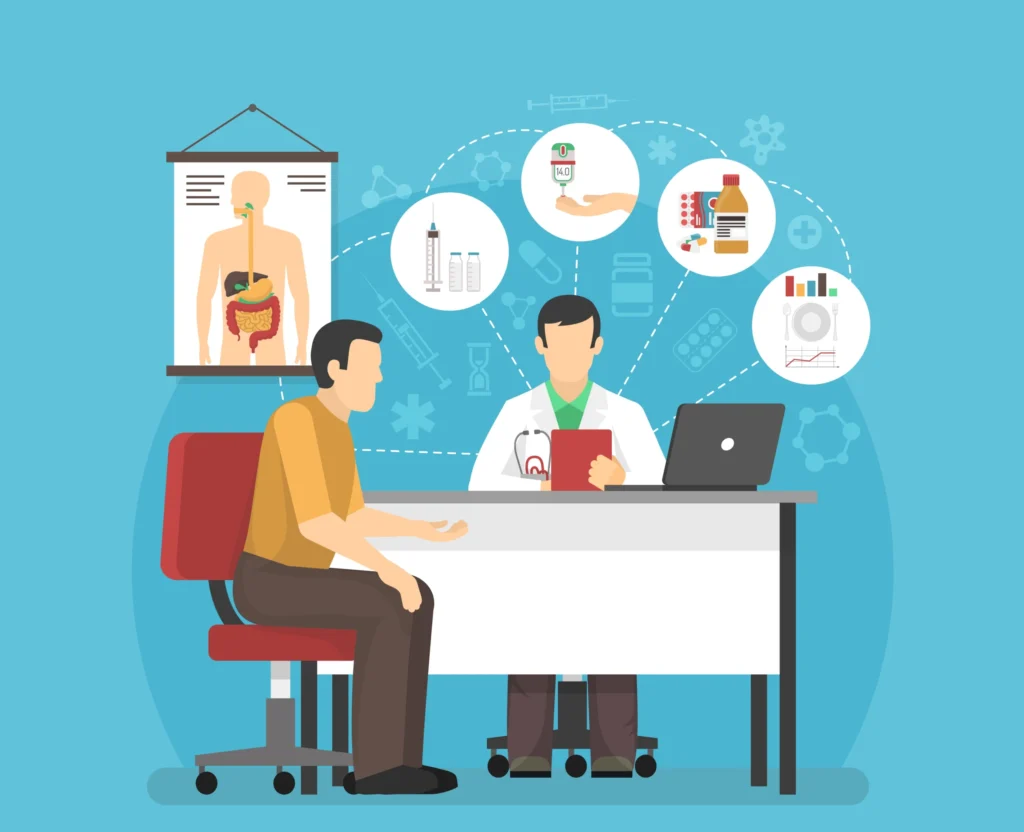
Conclusion
India stands at a pivotal moment in its battle against diabetes. The country faces one of the world’s fastest-growing diabetes burdens, driven by genetics, lifestyle transitions, urban diets, and an aging population. Yet unlike a decade ago, India now has access to a powerful ecosystem of technologies — Continuous Glucose Monitoring (CGM), smart insulin delivery, digital therapeutics, AI-driven risk prediction, remote monitoring, and wearables that contextualize glucose with daily habits. These tools do more than track numbers; they bring real-time insight, enable early intervention, and help patients prevent complications long before they reach critical stages. For millions of Indians who struggle with access, literacy, or affordability, the emergence of telemedicine and hybrid-care models means specialist-level support can finally reach small towns and rural clusters.
However, technology alone isn’t the solution. The bigger challenge lies in equity, affordability, and proper medical supervision. Many advanced devices remain expensive, insurance coverage is limited, and awareness gaps persist — especially in Tier-2/3 towns where diabetes is rising fastest. Without guided interpretation and doctor-led oversight, even the best CGM or app can mislead users or create false confidence. India needs a blended model where tech supports clinicians, not replaces them, and where mass-market education campaigns help people understand how to use these innovations safely and effectively. Long-term success will depend on reducing device costs, strengthening primary care, expanding government screening programs, and ensuring that digital tools are localized for Indian diets, languages, and cultural nuances.
For content creators, healthcare startups, educators, and entrepreneurs, this space represents a rare blend of high search demand, evergreen relevance, and meaningful social impact. Diabetes-related queries, reviews, comparisons, and tech explanations attract millions of monthly searches. Brands are actively seeking affiliate partnerships, creators are building communities around health optimization, and India’s policy push towards digital health adds momentum. By producing accurate, well-researched, clinically responsible content, creators can shape public understanding, help users adopt the right technologies, and contribute to a nationwide shift toward prevention-based healthcare. This is not just a trending niche — it’s a long-term, high-value category that will grow for years as India transforms how it manages chronic disease.
References & Sources
(Select authoritative sources used to write this article — include links on publish)
- International Diabetes Federation (IDF) — India country data, 2024. Diabetes Atlas+1
- Lancet / NCD Risk Factor Collaboration reports & Reuters coverage on 800+ million adults with diabetes (2024). Reuters+1
- Grand View Research — India Continuous Glucose Monitoring Devices Market Report (2024–2033). Grand View Research
- Mordor Intelligence — India CGM Market (estimates 2025). Mordor Intelligence
- WHO — Diabetes in India overview. World Health Organization
- Ministry of Health & Family Welfare (India) — NP-NCD / NPCDCS program guidelines. Ministry of Health and Family Welfare+1
- Recent journal reviews on AI and digital therapeutics in diabetes (summaries / industry reports). Mordor Intelligence+1
- News reporting on insulin access & local studies (example coverage). The Times of India+1
I’ll include a full reference list with exact URLs and (where needed) date accessed in the final CMS publish-ready file.




